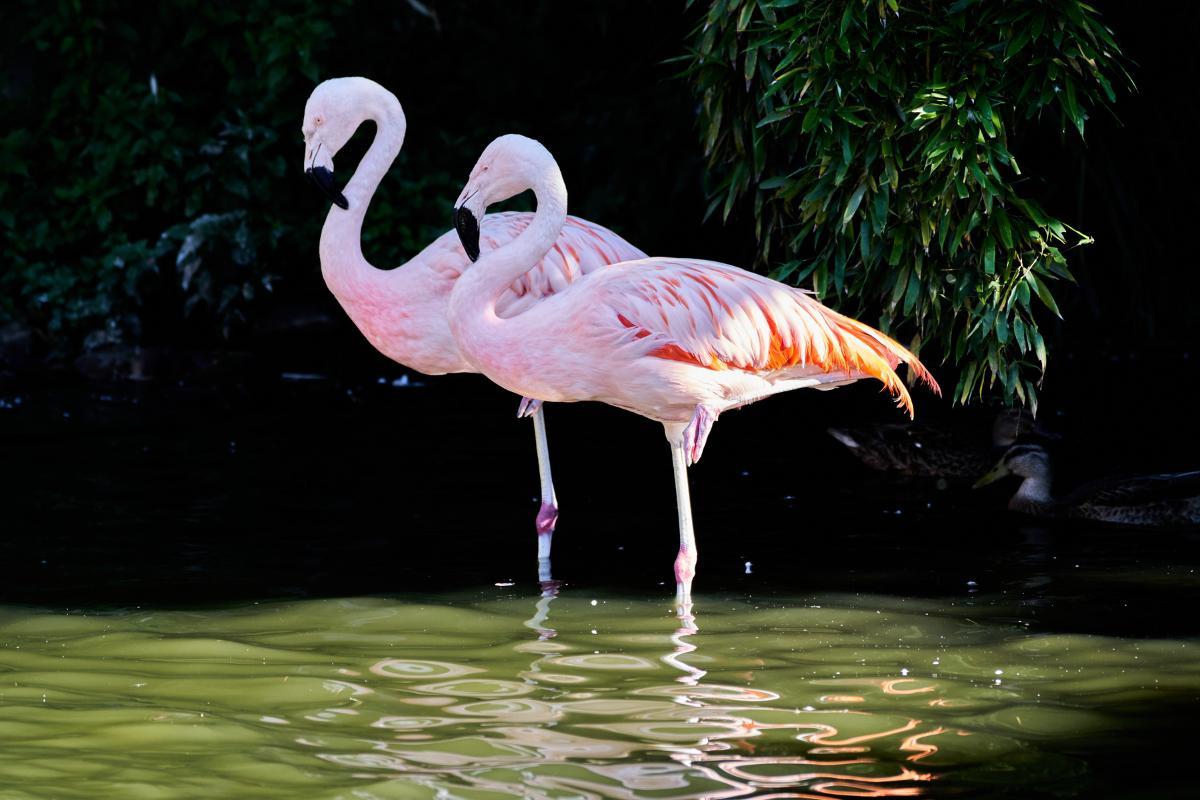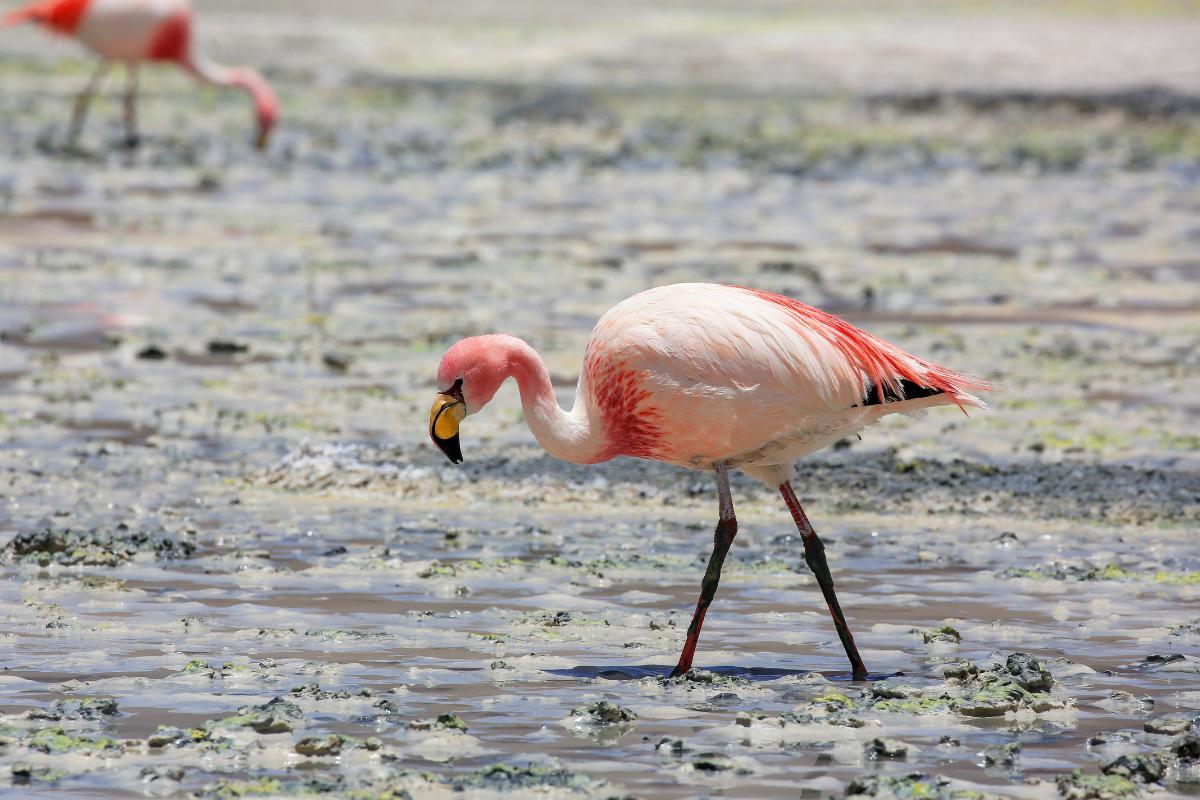Types of Flamingos - Different Flamingo Species


The different types of flamingos include the American flamingo (Phoenicopterus ruber), Chilean flamingo (Phoenicopterus chilensis), Andean flamingo (Phoenicoparrus andinus), puna or James's flamingo (Phoenicoparrus jamesi), greater flamingo (Phoenicopterus roseus) and the lesser flamingo (Phoeniconaias minor).
All types of flamingos are as beautiful as they are peculiar. These birds have long legs which keep them raised above the shallows waters in which they wade. They have a distinctive plumage which displays shades of pink, red and orange, colorations they derive from the carotenoid pigments they consume from plants and algae. When well fed they are a brighter pink, signifying attractiveness to a potential mate via possible reproductive advantage.
Despite all types of flamingos having these similar characteristics, there are some differences between species. We learn what they are at thedailyECO by finding out what are the different flamingo species. We find out about their individual characteristics and provide hotos of what they look like.
- How many types of flamingos are there?
- American flamingo (Phoenicopterus ruber)
- Chilean flamingo (Phoenicopterus chilensis)
- Andean flamingo (Phoenicoparrus andinus)
- Puna or James's flamingo (Phoenicoparrus jamesi)
- Greater flamingo (Phoenicopterus roseus)
- Lesser flamingo (Phoenicopterus minor)
- Which flamingos are in danger of extinction
How many types of flamingos are there?
Flamingos are known for their pink plumage, long legs, curved bill and the unique way they have of standing. This is because they particularly tall wading birds. They live in the shallow coastal waters of various countries around the world, including Africa, Europe and the Americas. With such long legs, they can wade in deeper water and search for the food that makes up their diet. This includes insects, algae, small crustaceans and certain plants.
It is not understood exactly why they do it, but all types of flamingo stand on one leg. It is widely believed that it is due to thermoregulation[1]. Standing on one leg can help them to conserve their heat by brining their extremity closer to the body.
There are six known species of flamingo. These are the following:
- American flamingo (Phoenicopterus ruber)
- Chilean flamingo (Phoenicopterus chilensis)
- Andean flamingo (Phoenicoparrus andinus)
- Puna or James's flamingo (Phoenicoparrus jamesi)
- Greater flamingo (Phoenicopterus roseus)
- Lesser flamingo (Phoeniconaias minor)
All flamingos belong to the family of wading birds known as Phoenicopteridae, but they are not all in the same genus. We find out more about the characteristics of each different flamingo species in the sections below with photos of each. You can also discover more about how birds are classified with our related article.
American flamingo (Phoenicopterus ruber)
As their name suggests, the American flamingo breeds in tropical regions of the Americas. They are especially known in the Yucatan in Mexico, Florida in the US, Honduras, northern Venezuela, Colombia and the Galapagos Islands. The flamingo has become emblematic of many of these regions, signifying idyllic climate and beautiful landscapes.
As you can see in the photo below, the plumage of the American flamingo is a very deep pink that appears almost red. This contrasts with the lighter plumage of their European flamingo cousins. They measure between 4-4.6' (1.2-1.4 m) in height, making them the largest flamingo native to the Americas.
American flamingos migrate over short distances to forage in nearby saltwater lakes. They have a very curved beak which allows them the ability to suck up and filter water for their food. The particles become trapped in the beak while the water escapes, meaning the flamingo doesn't ingest water needlessly.

Chilean flamingo (Phoenicopterus chilensis)
It is the flamenco with the greatest distribution in South America. Their habitat ranges from Peru and Bolivia to Chile and Argentina. It measures from 3.2-4.2' (1-1.3 m). It differs from other types of flamingo species due to the coloration of their legs. These ones are gray with pink knees, although they are not knees in the traditional sense. More than half their bill is black and the plumage is pinkish white.
If you want to learn about other types of birds, check out our article on the difference between a swift, swallow and house martin.

Andean flamingo (Phoenicoparrus andinus)
The first thing we might notice when comparing the Andean flamingo to other types of flamingos is that they have yellow legs. If we look more closely at the photo below, we'll also see they have a very deep lower jaw. They are slightly smaller than the Chilean flamingo overall, but they are the largest flamingo in the Andes. They usually fly from lake to lake to look for food. They have a black tail, but the neck, wing coverts and chest are pink.

Puna or James's flamingo (Phoenicoparrus jamesi)
The puna flamingo also live in the Andes, but they are the smallest species in this area. They are distinguished by their bill which is orange and straighter than many other types of flamingos. They are also known for the black tip on their bill. The base of the neck and back are reddish, but the tail is black. As the photo shows, they are not as black as the Andean flamingo.

Greater flamingo (Phoenicopterus roseus)
It is the flamingo that has the greatest distribution of all flamingo types. Their habitats can be found in southern and central Asia, Africa and southern Europe. The neck is particularly long, forming a pronounced U as it approaches the water. They do so to suck up the water with the algae and crustaceans that make up the typical flamingo diet. The wing feathers are bright red, while those on the body are light pink. It measures from 3.6-4.9' (1.1-1.5 m).

Lesser flamingo (Phoenicopterus minor)
It is the smallest flamingo of all flamingo types at 2.6-3.2' (0.8-1 m) in height. They live in South Asia and Africa, but can sometimes reach as far as Spain. They are found in large flocks in the alkaline lakes of the Rift Valley, where the Spirulina alga grows on which they mainly feed. Physically, it is identified because the beak is completely dark with a reddish tip. The plumage is light pink to whitish in color.

Which flamingos are in danger of extinction
These special birds have very particular habitats. Mainly due to the human influence on their natural habitat, many of them are in danger of extinction. The species cataloged with some type of risk by the IUCN Red List of Threatened Species are:
- Chilean flamingo (Phoenicopterus chilensis): considered near threatened with declining populations. The main cause is that there has been heavy looting of their eggs by egg collectors, especially in Bolivia. The most important nesting site in Argentina, called Mar Chiquita, has suffered a significant diversion of water to support local irrigation projects. Other causes are mining, direct hunting and pressure from tourism.
- Puna or James's flamingo (Phoenicoparrus jamesi): also near threatened. This is laregly due to climate change reducing diatoms, one of their staple foods. It is also threatened by the looting of eggs, mining and the pressure of tourism.
- Andean flamingo (Phoenicoparrus andinus): considered vulnerable, with declining populations. They also suffer from egg looting, which began in the mid-20th century. Other causes particular to this species are the low water levels of its habitat and erosion of nesting sites, as well as mining in Andean wetlands in search of gold, lithium, silica and salt. Learn more about the threats to Andean plants and animals.
- Lesser flamingo (Phoenicopterus minor): also considered ear threatened. There are only three breeding sites in Africa, due to hydroelectric power stations and mining. Some projects were put on hold due to this situation, but they have not been completely closed. Other threats are water pollution and appropriation of them.
Now that you know the different types of flamingos, you can discover more about other bird species with our article on what are the largest types of eagles?
If you want to read similar articles to Types of Flamingos - Different Flamingo Species, we recommend you visit our Wild animals category.
- Beatty, R., Beer, A., & Deeming, C. (2010). The book of nature. Great Britain: Dorling Kindersley.
- IUCN Red List of Threatened Species (n.d.) Phoenicopterus search. Retrieved from: https://www.iucnredlist.org/search?taxonomies=22676382&searchType=species











